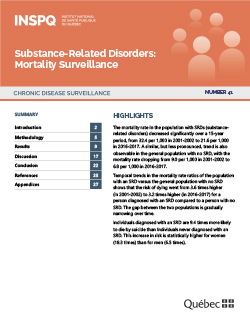The mortality rate in the population with SRDs (substancerelated disorders) decreased significantly over a 15-year period, from 32.4 per 1,000 in 2001-2002 to 21.6 per 1,000 in 2016-2017. A similar, but less pronounced, trend is also observable in the general population with no SRD, with the mortality rate dropping from 9.0 per 1,000 in 2001-2002 to 6.8 per 1,000 in 2016-2017.
Temporal trends in the mortality rate ratios of the population with an SRD versus the general population with no SRD shows that the risk of dying went from 3.6 times higher (in 2001-2002) to 3.2 times higher (in 2016-2017) for a person diagnosed with an SRD compared to a person with no SRD. The gap between the two populations is gradually narrowing over time.
Individuals diagnosed with an SRD are 9.4 times more likely to die by suicide than Individuals never diagnosed with an SRD. This increase in risk is statistically higher for women (18.3 times) than for men (6.5 times).


